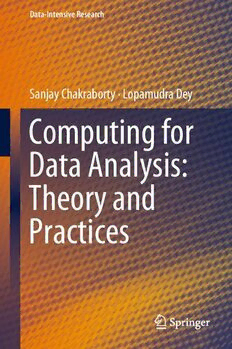
Computing for Data Analysis: Theory and Practices PDF
Preview Computing for Data Analysis: Theory and Practices
Data-Intensive Research Sanjay Chakraborty · Lopamudra Dey Computing for Data Analysis: Theory and Practices Data-Intensive Research SeriesEditors NilanjanDey,TechnoInternationalNewTown,Kolkata,WestBengal,India BijayaKetanPanigrahi,IndianInstituteofTechnologyDelhi,NewDelhi,India VincenzoPiuri,UniversityofMilan,Milano,Italy This book series provides a comprehensive and up-to-date collection of research and experimental works, summarizing state-of-the-art developments in the fields of data science and engineering. The trends, technologies and state-of-the art researchrelatedtodatacollection,storage,representation,visualization,processing, interpretation, analysis, and management related concepts, taxonomy, techniques, designs, approaches, systems, algorithms, tools, engines, applications, best prac- tices, bottlenecks, perspectives, policies, properties, practicalities, quality control, usage,validation,workflows,assessment,evaluation,metrics,andmanymoreareto becovered. Theserieswillpublishmonographs,editedvolumes,textbooksandproceedings of important conferences, symposia and meetings in the field of autonomic and data-drivencomputing. · Sanjay Chakraborty Lopamudra Dey Computing for Data Analysis: Theory and Practices SanjayChakraborty LopamudraDey DepartmentofComputerScience DepartmentofComputerScience andEngineering andEngineering TechnoInternationalNewTown HeritageInstituteofTechnology Kolkata,WestBengal,India Kolkata,WestBengal,India ISSN 2731-555X ISSN 2731-5568 (electronic) Data-IntensiveResearch ISBN 978-981-19-8003-9 ISBN 978-981-19-8004-6 (eBook) https://doi.org/10.1007/978-981-19-8004-6 ©TheEditor(s)(ifapplicable)andTheAuthor(s),underexclusivelicensetoSpringerNature SingaporePteLtd.2023 Thisworkissubjecttocopyright.AllrightsaresolelyandexclusivelylicensedbythePublisher,whether thewholeorpartofthematerialisconcerned,specificallytherightsoftranslation,reprinting,reuse ofillustrations,recitation,broadcasting,reproductiononmicrofilmsorinanyotherphysicalway,and transmissionorinformationstorageandretrieval,electronicadaptation,computersoftware,orbysimilar ordissimilarmethodologynowknownorhereafterdeveloped. Theuseofgeneraldescriptivenames,registerednames,trademarks,servicemarks,etc.inthispublication doesnotimply,evenintheabsenceofaspecificstatement,thatsuchnamesareexemptfromtherelevant protectivelawsandregulationsandthereforefreeforgeneraluse. Thepublisher,theauthors,andtheeditorsaresafetoassumethattheadviceandinformationinthisbook arebelievedtobetrueandaccurateatthedateofpublication.Neitherthepublishernortheauthorsor theeditorsgiveawarranty,expressedorimplied,withrespecttothematerialcontainedhereinorforany errorsoromissionsthatmayhavebeenmade.Thepublisherremainsneutralwithregardtojurisdictional claimsinpublishedmapsandinstitutionalaffiliations. ThisSpringerimprintispublishedbytheregisteredcompanySpringerNatureSingaporePteLtd. The registered company address is: 152 Beach Road, #21-01/04 Gateway East, Singapore 189721, Singapore ToourParents,SisterandmySonArohanfor theirloveandinspiration. —Dr.SanjayChakraborty —Dr.LopamudraDey Preface Dataanalyticsissignificantsinceitaidsintheperformanceoptimizationofenter- prises.Byfindingmorecost-effectivewaystodobusinessandretainingalotofdata, firmscanhelpcutexpensesbyincorporatingitintotheirbusinessstrategy.Analyzing data collections to identify trends and make judgments about the information they containisknownasDataAnalytics(DA).Dataanalyticsisincreasinglycarriedout withtheuseofspecialisthardwareandsoftware. This book has covered various cutting-edge computing technologies and their applications over data. We have discussed in-depth knowledge of big data and cloud computing, the Internet of Things, augmented and virtual reality, quantum computing,cognitivecomputing,andcomputationalbiologywithrespecttodifferent kindsofdataanalysisandtheirapplications.Inthisbook,wehavedescribedsome interesting models in the cloud, IoT, AR/VR systems, quantum, cognitive, and computationalbiologydomainsthatprovidesomeusefulimpactonintelligentdata (bulktimeseriesdata,emotional,imagedata,etc.)analysis.Wehavealsoexplained how these computing technologies-based data analysis approaches are used for various real-life applications. We believe this book will be benefited the readers whoareinterestedtoworkintheseareasinthefuture. Chapter1givesanoverallintroductiontothebasicsofbigdataanalytics,cloud dataanalytics,quantum,andIoT-baseddataanalytics,biologicaldataanalytics,and soon.Itdescribedtheimpactofdataanalysisonalltheseframeworksbriefly. Then under Part I, Chap. 2 discusses the roles and different techniques of big data analysis on a cloud platform. It first discusses the various types of big data analysisandhowthatdataanalysiscanbeperformedinHadooparchitecturethrough acloudframework.Tofindpatternsindataandderivefreshinsights,cloudanalytics entailsthecombinationofscalablecloudcomputingwithrobustanalyticaltools.Data analysisisbeingusedbycorporationstogainacompetitiveedge,enhancescientific research,andimprovepeople’slivesinavarietyofways.Therefore,itdescribesthe vii viii Preface basicsofthecloud,itsdifferentmodels,andarchitecturesandalsoexplainshowthey helptodoeffectivedataanalysis. Chapters 3 and 4 focus on the discussion of edge computing with the notions of the Internet of Things (IoT) and augmented/virtual (AR/VR) reality. Chapter 3 introducesthebasicconceptsofIoTalongwiththerelatedtechnologies,protocols, and architecture. Then, it describes the impact of IoT on various industrial appli- cations and big data analysis on cloud framework. Chapter 4 discusses the types of augmented reality with some specific system architectures. It also explains the differenthardwareandsoftwarecomponentsofAR/VRsystems.Italsopresentsthe differentreal-lifeapplicationsofdataanalysisandfutureresearchdirectionsinthis area. Chapter5underPartIItakesamorein-depthlookatdataanalysisintheBiocom- puting domain. In this domain, we discuss the basic concepts of computational biologyanditsvariousdatatypes.Besidesthat,itdescribesthedifferentdataanal- ysis processes on DNA/RNA sequences, microarray data sequences, and protein sequences. Chapter6discussesthedataanalysisthroughcognitivecomputing.Inthischapter, wedescribethebasicsofbrain–computerinterfacingtechniquesforfeatureextraction anditsvarious components.Italsopresentsthemethodology fortheclassification of emotional data through the analysis of EEG signals collected from the human brain. It has huge applications for those people who are getting distressed due to workpressureorotherissuesintheirdaytodaylife. In Part III, Chaps. 7 and 8 deal with the concepts of quantum computing that help to perform various machine learning and image processing operations on a setofreal-lifedataandimagematrices.Chapter7discussesthebasicsofquantum machinelearningconceptsandhowtheycanbeutilizedtosolvesomecomplexclus- teringandclassificationproblemsmoreefficientlycomparedtoclassicalcomputing. Similarly,twoimportantandcompleximageprocessingoperations(denoisingand edge detection) that can be solved more efficiently and faster way in the quantum frameworkarediscussedinChap.8. Finally,Chap.9underPartIVsummarizestheconceptspresentedinthisbookand discusses applications and trends in data analysis. Social impacts of data analysis, such as privacy and data security issues, are discussed, in addition to challenging researchissues. Preface ix Thisbookhasseveralstrongfeaturesthatsetitapartfromothertextsoncomputing fordataanalysis.Itpresentsverybroadyetin-depthcoverageofthespectrumofdata analysisovervariouspopularcomputingdomains,especiallyregardingseveralrecent researchtopicsondatacomputing. Dr.SanjayChakraborty AssociateProfessor DepartmentofComputerScienceandEngineering TechnoInternationalNewTown Kolkata,India Dr.LopamudraDey AssistantProfessor DepartmentofComputerScienceandEngineering HeritageInstituteofTechnology Kolkata,India Acknowledgements We express our great pleasure, sincere thanks, and gratitude to the people who significantly helped, contributed, and supported the completion of this book. We aresincerelythankfultoDr.RadhaTamalGoswami,ProfessorandDirector,Techno International Newtown, Kolkata, India, for his encouragement, support, guidance, advice, and suggestions to complete this book. Our sincere thanks to Dr. Amlan Chakrabarti, Professor and Head, AKCSIT, University of Calcutta, India, and Dr. Anirban Mukhopadhyay, Professor, Department of Computer Science and Engi- neering,UniversityofKalyani,Kalyani,India,fortheircontinuoussupport,advice, andcordialguidancefromthebeginningtothecompletionofthisbook. We would also like to express our honest appreciation to our colleagues at the TechnoInternationalNewtown,India,andHeritageInstituteofTechnology,Kolkata, fortheirguidanceandsupport. Wearealsoverythankfultothereviewersforreviewingthebookchapters.This bookwouldnothavebeenpossiblewithouttheircontinuoussupportandcommitment towardcompletingthereviewontime. Tocompletethisbook,theentirestaffatSpringerextendedtheirkindcooperation, timelyresponse,expertcomments,andguidance,andweareverythankfultothem. Finally, we sincerely express our special and heartfelt respect, gratitude, and gratefulness to our family members and parents for their endless support and blessings. Kolkata,India Dr.SanjayChakraborty Dr.LopamudraDey xi
